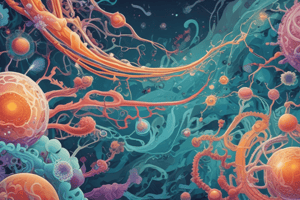Podcast
Questions and Answers
What is a major advantage of continuous culture systems?
What is a major advantage of continuous culture systems?
- They are essential for the study of interactions between microbial species under all environmental conditions.
- They provide a constant supply of cells in the exponential phase and growing at a known rate. (correct)
- They allow for the study of microbial growth at high nutrient levels.
- They are only used in food microbiology.
What is the optimum temperature for most pathogenic bacteria?
What is the optimum temperature for most pathogenic bacteria?
- 40°C
- 37°C (correct)
- 25°C
- 30°C
What is the characteristic of obligate anaerobes?
What is the characteristic of obligate anaerobes?
- They require oxygen for growth.
- They lack superoxide dismutase and catalase. (correct)
- They are phototrophs.
- They can grow in the presence or absence of oxygen.
What is the term for bacteria that require higher amounts of CO2 for their growth?
What is the term for bacteria that require higher amounts of CO2 for their growth?
What is the classification of bacteria based on their energy source?
What is the classification of bacteria based on their energy source?
What is the term for bacteria that can grow in the presence of oxygen?
What is the term for bacteria that can grow in the presence of oxygen?
What affects bacterial growth?
What affects bacterial growth?
What type of bacteria lack superoxide dismutase and catalase?
What type of bacteria lack superoxide dismutase and catalase?
What is the importance of continuous culture systems in research?
What is the importance of continuous culture systems in research?
What is the phase of microbial growth in a closed system?
What is the phase of microbial growth in a closed system?
Flashcards are hidden until you start studying
Study Notes
Bacterial Growth
- Microbial growth is defined as an increase in cellular constituents resulting in an increase in microorganism size, population number, or both.
Generation Time
- Generation time is the time required for a bacterium to give rise to two daughter cells under optimum conditions.
Bacterial Growth Curve
Lag Phase
- The lag phase occurs when microorganisms are inoculated into fresh culture medium and do not reproduce immediately.
- During the lag phase, bacterial cells synthesize new components, but there is no net increase in mass.
- The lag phase varies in length depending on surrounding conditions, such as the age of the inoculum and the differences in the surrounding medium.
Exponential (Log) Phase
- Microorganisms start replicating their number in logarithmic order at a maximal rate.
- During the log phase, microorganisms grow under constant conditions, including nutrient and division rates, causing uniform and identical new cells at regular intervals.
- The population is most uniform in chemical and physiological characteristics, making it ideal for biochemical and physiological studies.
Stationary Phase
- In the stationary phase, the total number of viable microorganisms remains constant due to a balance between cell division and cell death.
- The population may cease to divide but remain metabolically active.
- Microbial populations enter the stationary phase due to reasons such as nutrient limitation, accumulation of toxic waste products, and oxygen availability.
Death Phase
- The death phase occurs when the number of viable cells declines due to unsuitable conditions.
- Death is defined as the irreversible loss of the ability to reproduce.
Measurement of Microbial Growth
- Measurement of microbial growth can be determined by measuring cell numbers or cell mass.
Types of Culture Systems
Batch Cultures or Closed System
- In batch cultures, nutrient supplies are not renewed, and wastes are not removed, resulting in a limited exponential growth phase.
Continuous Culture System (Open System)
- Microorganisms grow in a system with constant environmental conditions maintained through continual provision of nutrients and removal of wastes.
Factors Affecting Bacterial Growth
Oxygen
- Bacteria can be classified into aerobic and anaerobic bacteria based on their oxygen requirements.
Carbon Dioxide
- Capnophilic bacteria require higher amounts of CO2 for their growth.
Light
- Bacteria can be classified as phototrophs (energy from sunlight) or chemotrophs (energy from chemical sources).
Temperature
- The optimum temperature for most pathogenic bacteria is 37°C.
- Bacteria can be grouped based on their temperature range, such as psychrophilic, mesophilic, thermophilic, and extremophilic.
Studying That Suits You
Use AI to generate personalized quizzes and flashcards to suit your learning preferences.



